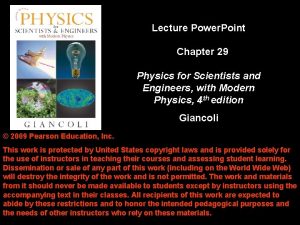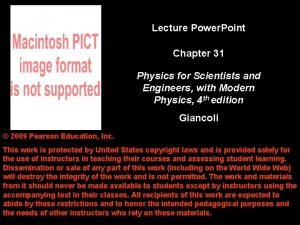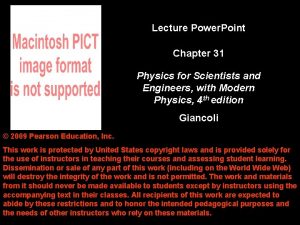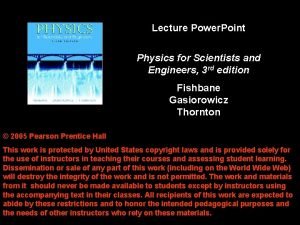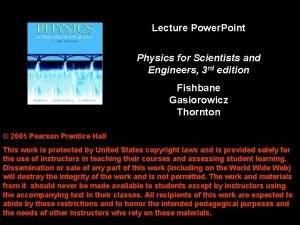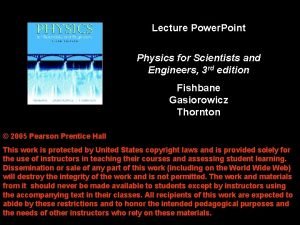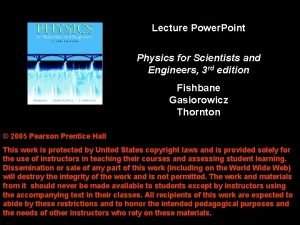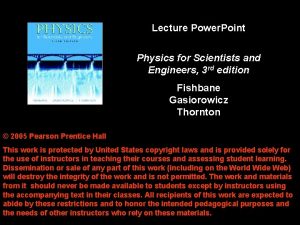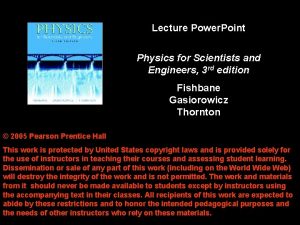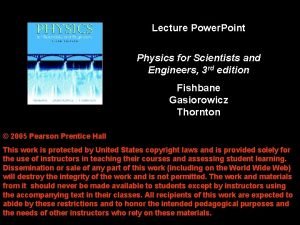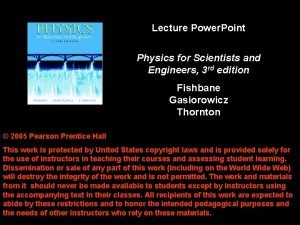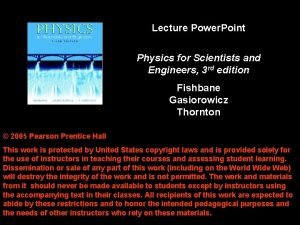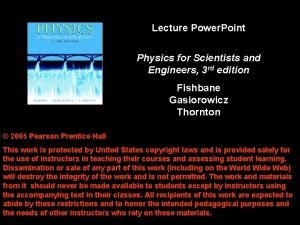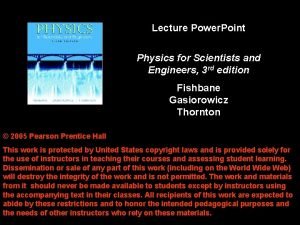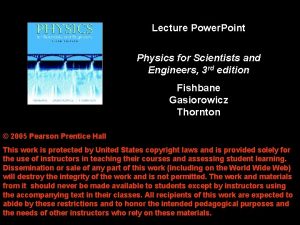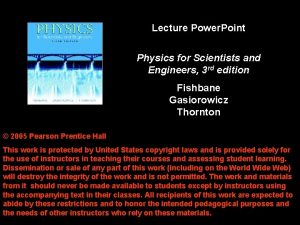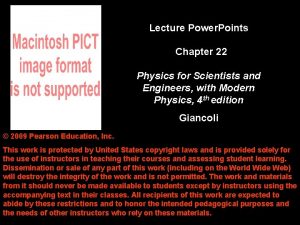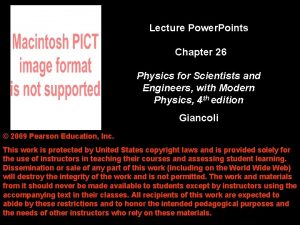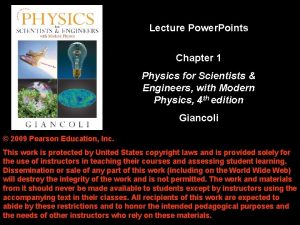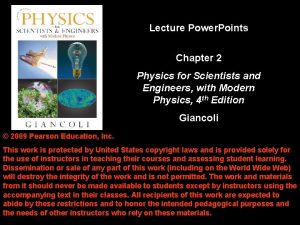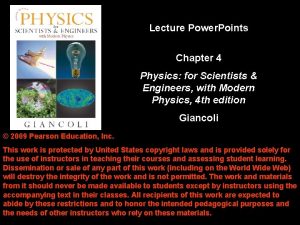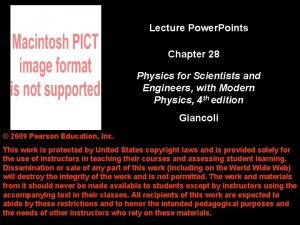Lecture Power Point Chapter 30 Physics for Scientists



















































- Slides: 51

Lecture Power. Point Chapter 30 Physics for Scientists and Engineers, with Modern Physics, 4 th edition Giancoli © 2009 Pearson Education, Inc. This work is protected by United States copyright laws and is provided solely for the use of instructors in teaching their courses and assessing student learning. Dissemination or sale of any part of this work (including on the World Wide Web) will destroy the integrity of the work and is not permitted. The work and materials from it should never be made available to students except by instructors using the accompanying text in their classes. All recipients of this work are expected to abide by these restrictions and to honor the intended pedagogical purposes and the needs of other instructors who rely on these materials.

Chapter 30 Inductance, Electromagnetic Oscillations, and AC Circuits Copyright © 2009 Pearson Education, Inc.

Units of Chapter 30 • Mutual Inductance • Self-Inductance • Energy Stored in a Magnetic Field • LR Circuits • LC Circuits and Electromagnetic Oscillations • LC Circuits with Resistance (LRC Circuits) • AC Circuits with AC Source Copyright © 2009 Pearson Education, Inc.

Units of Chapter 30 • LRC Series AC Circuit • Resonance in AC Circuits • Impedance Matching • Three-Phase AC Copyright © 2009 Pearson Education, Inc.

30 -1 Mutual Inductance Mutual inductance: a changing current in one coil will induce a current in a second coil: And vice versa; note that the constant M, known as the mutual inductance, is the same: Copyright © 2009 Pearson Education, Inc.

30 -1 Mutual Inductance Unit of inductance: the henry, H: 1 H = 1 V·s/A = 1 Ω·s. A transformer is an example of mutual inductance. Copyright © 2009 Pearson Education, Inc.

30 -1 Mutual Inductance Example 30 -1: Solenoid and coil. A long thin solenoid of length l and cross-sectional area A contains N 1 closely packed turns of wire. Wrapped around it is an insulated coil of N 2 turns. Assume all the flux from coil 1 (the solenoid) passes through coil 2, and calculate the mutual inductance. Copyright © 2009 Pearson Education, Inc.

30 -1 Mutual Inductance Conceptual Example 30 -2: Reversing the coils. How would Example 30– 1 change if the coil with turns was inside the solenoid rather than outside the solenoid? Copyright © 2009 Pearson Education, Inc.

30 -2 Self-Inductance A changing current in a coil will also induce an emf in itself: Here, L is called the self-inductance: Copyright © 2009 Pearson Education, Inc.

30 -2 Self-Inductance Example 30 -3: Solenoid inductance. (a) Determine a formula for the self-inductance L of a tightly wrapped and long solenoid containing N turns of wire in its length l and whose cross-sectional area is A. (b) Calculate the value of L if N = 100, l = 5. 0 cm, A = 0. 30 cm 2, and the solenoid is air filled. Copyright © 2009 Pearson Education, Inc.

30 -2 Self-Inductance Conceptual Example 30 -4: Direction of emf in inductor. Current passes through a coil from left to right as shown. (a) If the current is increasing with time, in which direction is the induced emf? (b) If the current is decreasing in time, what then is the direction of the induced emf? Copyright © 2009 Pearson Education, Inc.

30 -2 Self-Inductance Example 30 -5: Coaxial cable inductance. Determine the inductance per unit length of a coaxial cable whose inner conductor has a radius r 1 and the outer conductor has a radius r 2. Assume the conductors are thin hollow tubes so there is no magnetic field within the inner conductor, and the magnetic field inside both thin conductors can be ignored. The conductors carry equal currents I in opposite directions. Copyright © 2009 Pearson Education, Inc.

30 -3 Energy Stored in a Magnetic Field Just as we saw that energy can be stored in an electric field, energy can be stored in a magnetic field as well, in an inductor, for example. Analysis shows that the energy density of the field is given by Copyright © 2009 Pearson Education, Inc.

30 -4 LR Circuits A circuit consisting of an inductor and a resistor will begin with most of the voltage drop across the inductor, as the current is changing rapidly. With time, the current will increase less and less, until all the voltage is across the resistor. Copyright © 2009 Pearson Education, Inc.

30 -4 LR Circuits The sum of potential differences around the loop gives Integrating gives the current as a function of time: . The time constant of an LR circuit is. Copyright © 2009 Pearson Education, Inc. .

30 -4 LR Circuits If the circuit is then shorted across the battery, the current will gradually decay away: . Copyright © 2009 Pearson Education, Inc.

30 -4 LR Circuits Example 30 -6: An LR circuit. At t = 0, a 12. 0 -V battery is connected in series with a 220 -m. H inductor and a total of 30Ω resistance, as shown. (a) What is the current at t = 0? (b) What is the time constant? (c) What is the maximum current? (d) How long will it take the current to reach half its maximum possible value? (e) At this instant, at what rate is energy being delivered by the battery, and (f) at what rate is energy being stored in the inductor’s magnetic field? Copyright © 2009 Pearson Education, Inc.

30 -5 LC Circuits and Electromagnetic Oscillations An LC circuit is a charged capacitor shorted through an inductor. Copyright © 2009 Pearson Education, Inc.

30 -5 LC Circuits and Electromagnetic Oscillations Summing the potential drops around the circuit gives a differential equation for Q: This is the equation for simple harmonic motion, and has solutions. . Copyright © 2009 Pearson Education, Inc.

30 -5 LC Circuits and Electromagnetic Oscillations Substituting shows that the equation can only be true for all times if the frequency is given by The current is sinusoidal as well: Copyright © 2009 Pearson Education, Inc.

30 -5 LC Circuits and Electromagnetic Oscillations The charge and current are both sinusoidal, but with different phases. Copyright © 2009 Pearson Education, Inc.

30 -5 LC Circuits and Electromagnetic Oscillations The total energy in the circuit is constant; it oscillates between the capacitor and the inductor: Copyright © 2009 Pearson Education, Inc.

30 -5 LC Circuits and Electromagnetic Oscillations Example 30 -7: LC circuit. A 1200 -p. F capacitor is fully charged by a 500 -V dc power supply. It is disconnected from the power supply and is connected, at t = 0, to a 75 -m. H inductor. Determine: (a) the initial charge on the capacitor; (b) the maximum current; (c) the frequency f and period T of oscillation; and (d) the total energy oscillating in the system. Copyright © 2009 Pearson Education, Inc.

30 -6 LC Oscillations with Resistance (LRC Circuit) Any real (nonsuperconducting) circuit will have resistance. Copyright © 2009 Pearson Education, Inc.

30 -6 LC Oscillations with Resistance (LRC Circuit) Now the voltage drops around the circuit give The solutions to this equation are damped harmonic oscillations. The system will be underdamped for R 2 < 4 L/C, and overdamped for R 2 > 4 L/C. Critical damping will occur when R 2 = 4 L/C. Copyright © 2009 Pearson Education, Inc.

30 -6 LC Oscillations with Resistance (LRC Circuit) This figure shows the three cases of underdamping, overdamping, and critical damping. Copyright © 2009 Pearson Education, Inc.

30 -6 LC Oscillations with Resistance (LRC Circuit) The angular frequency for underdamped oscillations is given by. The charge in the circuit as a function of time is. Copyright © 2009 Pearson Education, Inc.

30 -6 LC Oscillations with Resistance (LRC Circuit) Example 30 -8: Damped oscillations. At t = 0, a 40 -m. H inductor is placed in series with a resistance R = 3. 0 Ω and a charged capacitor C = 4. 8 μF. (a) Show that this circuit will oscillate. (b) Determine the frequency. (c) What is the time required for the charge amplitude to drop to half its starting value? (d) What value of R will make the circuit nonoscillating? Copyright © 2009 Pearson Education, Inc.

30 -7 AC Circuits with AC Source Resistors, capacitors, and inductors have different phase relationships between current and voltage when placed in an ac circuit. The current through a resistor is in phase with the voltage. Copyright © 2009 Pearson Education, Inc.

30 -7 AC Circuits with AC Source The voltage across the inductor is given by or. Therefore, the current through an inductor lags the voltage by 90°. Copyright © 2009 Pearson Education, Inc.

30 -7 AC Circuits with AC Source The voltage across the inductor is related to the current through it: . The quantity XL is called the inductive reactance, and has units of ohms: Copyright © 2009 Pearson Education, Inc.

30 -7 AC Circuits with AC Source Example 30 -9: Reactance of a coil. A coil has a resistance R = 1. 00 Ω and an inductance of 0. 300 H. Determine the current in the coil if (a) 120 -V dc is applied to it, and (b) 120 -V ac (rms) at 60. 0 Hz is applied. Copyright © 2009 Pearson Education, Inc.

30 -7 AC Circuits with AC Source The voltage across the capacitor is given by. Therefore, in a capacitor, the current leads the voltage by 90°. Copyright © 2009 Pearson Education, Inc.

30 -7 AC Circuits with AC Source The voltage across the capacitor is related to the current through it: . The quantity XC is called the capacitive reactance, and (just like the inductive reactance) has units of ohms: Copyright © 2009 Pearson Education, Inc.

30 -7 AC Circuits with AC Source Example 30 -10: Capacitor reactance. What is the rms current in the circuit shown if C = 1. 0 μF and Vrms = 120 V? Calculate (a) for f = 60 Hz and then (b) for f = 6. 0 x 105 Hz. Copyright © 2009 Pearson Education, Inc.

30 -7 AC Circuits with AC Source This figure shows a high-pass filter (allows an ac signal to pass but blocks a dc voltage) and a low-pass filter (allows a dc voltage to be maintained but blocks higher-frequency fluctuations). Copyright © 2009 Pearson Education, Inc.

30 -8 LRC Series AC Circuit Analyzing the LRC series AC circuit is complicated, as the voltages are not in phase – this means we cannot simply add them. Furthermore, the reactances depend on the frequency. Copyright © 2009 Pearson Education, Inc.

30 -8 LRC Series AC Circuit We calculate the voltage (and current) using what are called phasors – these are vectors representing the individual voltages. Here, at t = 0, the current and voltage are both at a maximum. As time goes on, the phasors will rotate counterclockwise. Copyright © 2009 Pearson Education, Inc.

30 -8 LRC Series AC Circuit Some time t later, the phasors have rotated. Copyright © 2009 Pearson Education, Inc.

30 -8 LRC Series AC Circuit The voltages across each device are given by the x-component of each, and the current by its x-component. The current is the same throughout the circuit. Copyright © 2009 Pearson Education, Inc.

30 -8 LRC Series AC Circuit We find from the ratio of voltage to current that the effective resistance, called the impedance, of the circuit is given by Copyright © 2009 Pearson Education, Inc.

30 -8 LRC Series AC Circuit The phase angle between the voltage and the current is given by or The factor cos φ is called the power factor of the circuit. Copyright © 2009 Pearson Education, Inc.

30 -8 LRC Series AC Circuit Example 30 -11: LRC circuit. Suppose R = 25. 0 Ω, L = 30. 0 m. H, and C = 12. 0 μF, and they are connected in series to a 90. 0 -V ac (rms) 500 -Hz source. Calculate (a) the current in the circuit, (b) the voltmeter readings (rms) across each element, (c) the phase angle , and (d) the power dissipated in the circuit. Copyright © 2009 Pearson Education, Inc.

30 -9 Resonance in AC Circuits The rms current in an ac circuit is Clearly, Irms depends on the frequency. Copyright © 2009 Pearson Education, Inc.

30 -9 Resonance in AC Circuits We see that Irms will be a maximum when XC = XL; the frequency at which this occurs is f 0 = ω0/2π is called the resonant frequency. Copyright © 2009 Pearson Education, Inc.

30 -10 Impedance Matching When one electrical circuit is connected to another, maximum power is transmitted when the output impedance of the first equals the input impedance of the second. The power delivered to the circuit will be a minimum when d. P/dt = 0; this occurs when R 1 = R 2. Copyright © 2009 Pearson Education, Inc.

30 -11 Three-Phase AC Transmission lines usually transmit threephase ac power, with the phases being separated by 120°. This makes the power flow much smoother than if a single phase were used. Copyright © 2009 Pearson Education, Inc.

30 -11 Three-Phase AC Example 30 -12: Three-phase circuit. In a three-phase circuit, 266 V rms exists between line 1 and ground. What is the rms voltage between lines 2 and 3? Copyright © 2009 Pearson Education, Inc.

Summary of Chapter 30 • Mutual inductance: • Self-inductance: • Energy density stored in magnetic field: Copyright © 2009 Pearson Education, Inc.

Summary of Chapter 30 • LR circuit: . . • Inductive reactance: • Capacitive reactance: Copyright © 2009 Pearson Education, Inc.

Summary of Chapter 30 • LRC series circuit: . • Resonance in LRC series circuit: Copyright © 2009 Pearson Education, Inc.
 01:640:244 lecture notes - lecture 15: plat, idah, farad
01:640:244 lecture notes - lecture 15: plat, idah, farad Draw power triangle
Draw power triangle Informsu
Informsu Point point power
Point point power Physics 111 lecture notes
Physics 111 lecture notes Physics 101 lecture
Physics 101 lecture Phy101 lecture 1
Phy101 lecture 1 Physics 101 lecture notes pdf
Physics 101 lecture notes pdf Waves physics pdf
Waves physics pdf Atmospheric physics lecture notes
Atmospheric physics lecture notes Power system dynamics and stability lecture notes
Power system dynamics and stability lecture notes Zline 667-36
Zline 667-36 Power semiconductor devices lecture notes
Power semiconductor devices lecture notes Switch mode power supply lecture notes
Switch mode power supply lecture notes Power system dynamics and stability lecture notes
Power system dynamics and stability lecture notes What are some traditions in things fall apart
What are some traditions in things fall apart Why does it happen
Why does it happen University physics with modern physics fifteenth edition
University physics with modern physics fifteenth edition Physics ia idea
Physics ia idea Formuö
Formuö Typiska novell drag
Typiska novell drag Tack för att ni lyssnade bild
Tack för att ni lyssnade bild Vad står k.r.å.k.a.n för
Vad står k.r.å.k.a.n för Varför kallas perioden 1918-1939 för mellankrigstiden
Varför kallas perioden 1918-1939 för mellankrigstiden En lathund för arbete med kontinuitetshantering
En lathund för arbete med kontinuitetshantering Särskild löneskatt för pensionskostnader
Särskild löneskatt för pensionskostnader Tidbok
Tidbok Sura för anatom
Sura för anatom Vad är densitet
Vad är densitet Datorkunskap för nybörjare
Datorkunskap för nybörjare Tack för att ni lyssnade bild
Tack för att ni lyssnade bild Hur skriver man en debattartikel
Hur skriver man en debattartikel Delegerande ledarstil
Delegerande ledarstil Nyckelkompetenser för livslångt lärande
Nyckelkompetenser för livslångt lärande Påbyggnader för flakfordon
Påbyggnader för flakfordon Vätsketryck formel
Vätsketryck formel Offentlig förvaltning
Offentlig förvaltning I gullregnens månad
I gullregnens månad Presentera för publik crossboss
Presentera för publik crossboss Vad är ett minoritetsspråk
Vad är ett minoritetsspråk Plats för toran ark
Plats för toran ark Treserva lathund
Treserva lathund Epiteltyper
Epiteltyper Bästa kameran för astrofoto
Bästa kameran för astrofoto Centrum för kunskap och säkerhet
Centrum för kunskap och säkerhet Lågenergihus nyproduktion
Lågenergihus nyproduktion Mat för idrottare
Mat för idrottare Verktyg för automatisering av utbetalningar
Verktyg för automatisering av utbetalningar Rutin för avvikelsehantering
Rutin för avvikelsehantering Smärtskolan kunskap för livet
Smärtskolan kunskap för livet Ministerstyre för och nackdelar
Ministerstyre för och nackdelar Tack för att ni har lyssnat
Tack för att ni har lyssnat




















































